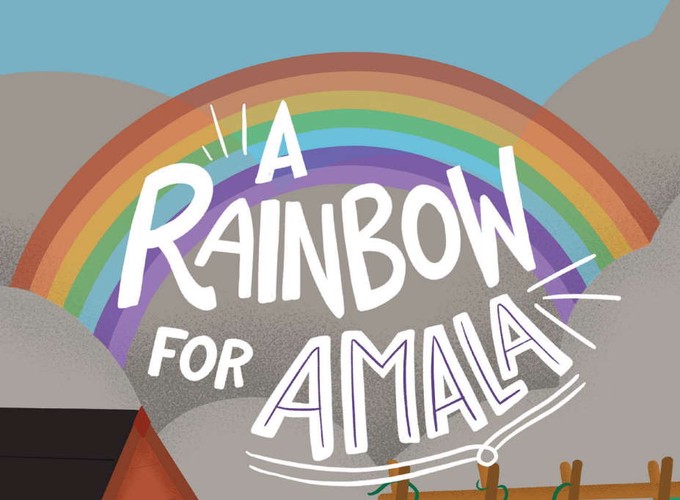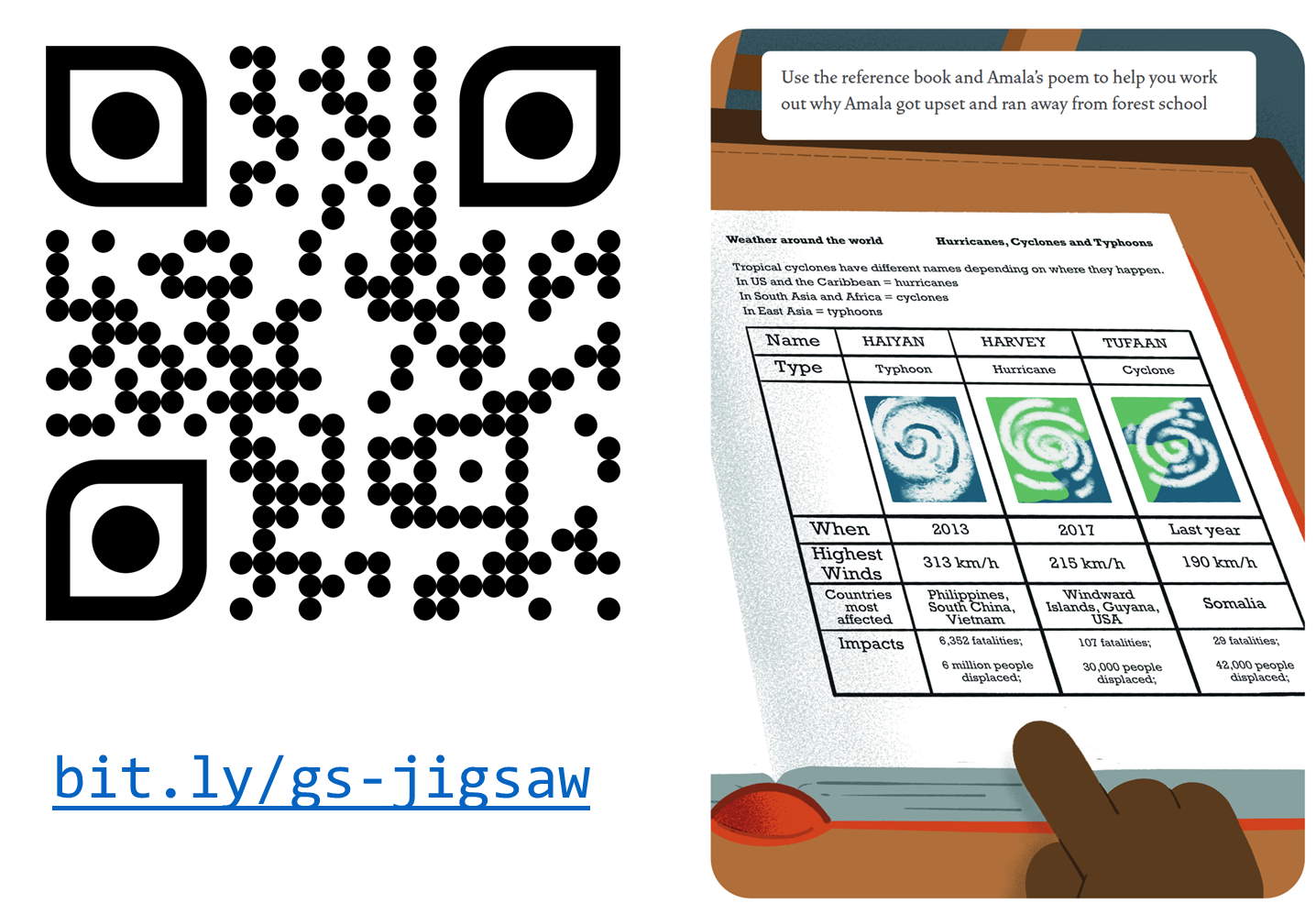Introduction
‘A Rainbow for Amala’ is a new interactive experience for children and their grandparents addressing the climate emergency. It’s currently a Work-In-Progress although you can play a small prototype right now.
Together a grandparent and grandchild would play through an experience than combines a physical printed book along with online digital content. In the prototype we use QR codes to trigger the digital sections but the final experience use Augmented Reality.
Throughout the book we plan to include positive climate change activities for the Grandparent and Grandchild to complete together such as encouraging more recycling, using active travel, meat-free days with the potential for more advances activisms such as involving their school, writing to a local councillor or getting involved in national campaigns. Children may be able to evidence these online and share with other readers of the book.
The final activity is to pass the book on to a friend so that the book itself has a continued existence and the word spreads rather than being stored on a shelf as a kind of trophy.
The Story
The story focuses on three young friends: Amala, Nafessa and Karim who live in Birmingham. The story begins with the children outside at their ‘Forest School’. They are writing haiku poems to celebrate their names. Suddenly, Amala rips up her poem, throws the pieces into the fire pit and runs off. This begins the journey of Nafessa and Karim trying to understand more about Amala’s life and what triggered her behaviour. The players join Nafessa and Karim as they visit other members of their families and community, solve puzzles and piece together the mystery.
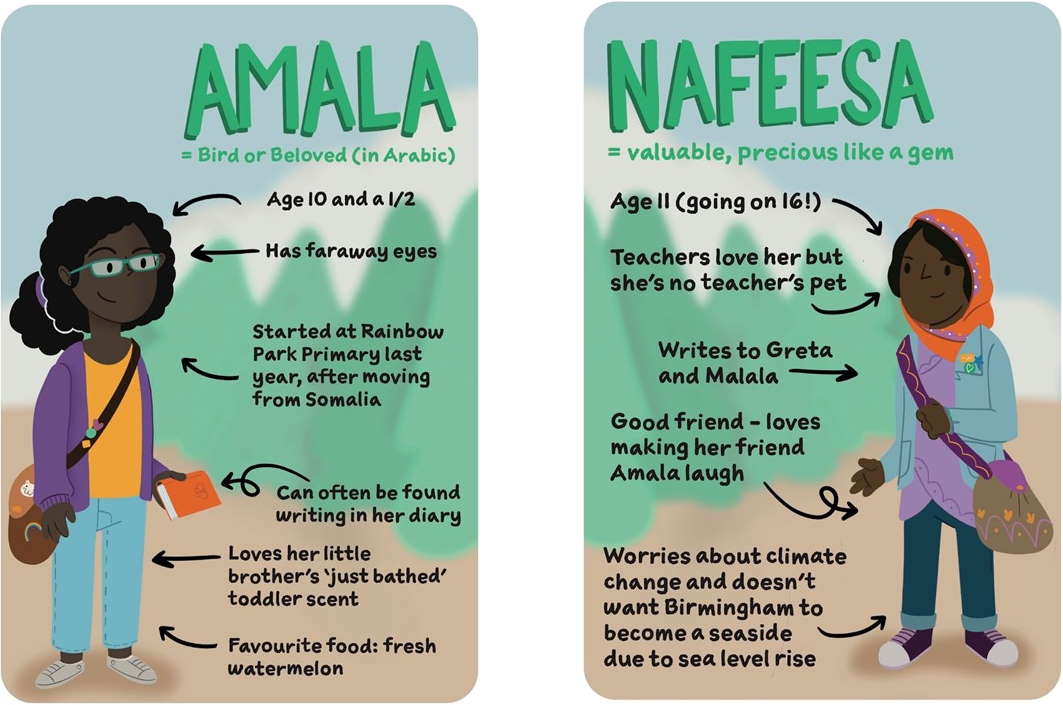
Play-test our Taster Experience
We’d love to get some feedback even at this early stage. While the final product will be designed for children to play with a grandparent – you can still play even if you don’t have a grandparent handy! It will probably take around 15-20 minutes and you’ll need a phone with a QR code reader. Fortunately, nearly all phones have that ability built into the camera app. Ideally, you’d print the pages of the book out but it will work fine if you view the pdf on a laptop or tablet.
Download the pdf of the book here
If you do have feedback, you can contact me or email Katie at [email protected] with your responses, comments and questions.
If you’d like to learn more about the development process and the team then read on…
Inspiration
Katie and I collaborated on ‘A Moment of Madness’. AMoM is an immersive experience with live actors and Escape Game style puzzles where the players are on a stake-out in a multi-story car-park tracking politician Michael Makerson (just another politician with a closet full of scandals!). As well as being a real-world experience we also created an online version – still with live actors and players on a stake-out but this time hosted over Zoom.
Both online and real-world experiences combine theatre, play, puzzles, technology in a way to tell the story. The story comes in all different ways: text messages, acted scenes, pre-recorded video, intercepted documents, social media posts. Players must work to interpret this combination of information in order to come to a conclusion as to what is really going on in our Michael Makerson’s world. In AMoM, the players get to vote on the outcome based on their findings.
We wanted to use similar methods of story-telling with technology and puzzles and work with a different audience. A Rainbow for Amala (ARfA from here onwards!). And the theme of AMoM is the political aspects of Climate Change so it’s not a complete leap in terms of topic.
Larger audience with a physical product?
One of the limitations of creating live work is that it’s only possible for an audience to experience it at a certain time in a certain location. AMoM generally has fairly short runs as part of a festival and then disappears again. This means that by the time word has spread and there’s a bigger demand – the chances are that we’ve already left town. By having a physical book that can be enjoyed at any time (and passed on) hopefully there’s the potential for a longer term audience. Our online components may allow to connect this growing audience over time.
The Switch to Physical Product
When lockdown originally happened there were huge consequences for many industries particularly hospitality and entertainment. Escape Rooms which require players to go to a physical location were very badly hit. As a response to this many looked at taking their games to the players – either but converting them to Zoom based avatar games (you can see a couple of mine here and here) or creating downloadable / physical experiences.
The transition from Live event to Physical isn’t something new to us. In 2014, we built a prototype, Agent in a Box, where players receive a package and burner mobile phone when they check-in to a hotel. They begin playing the game from the safety of their hotel room and are supporting an Agent working in the field. The ideas behind this eventually fed into the development of AMoM. There’s definitely something immersive about playing a character (the spy) in an unfamiliar environment (the hotel room) – so maybe someone can revisit this idea. I know of AirBnb apartment hires that are crossed with Escape Games – although have yet to try them.
If you like the sound of ‘Agent in a Box’ – there’s a whole industry that has grown up around play at home mystery experiences. Many are subscription based so you get a new chapter in the post every couple of months.

The Creative Team
I’m sure by now it’s pretty apparent that Katie and I are working together on this. We’ve also been joined right from the beginning by the multi-talented Sudha Bhuchar who is the writer on the project. As well as her illustrious writing career, Sudha is also know for her acting. She’s currently appearing on BBC mini series ‘Rules of the Game’ and on Radio 4 drama ‘Bangla Bantams’. Both highly recommended!
More recently we’ve had wonderful illustrator and designer Jimmy Rogers join us to turn our visions into reality. He’s also been responsible for the mini-video content sections in the prototype.
In addition, the project has been co-created by the students in Years 4,5 and 6 from Regents Park Community Primary School in Birmingham. We have visited their school on a number of occasions and their involvement has been invaluable in terms of market research (reading ability / interest), story inspiration, creative input and even script rewriting! We had the students in Year 6 act out some of Sudha’s script in pairs and then change bits to make it more natural from themselves. This fed back into the final versions. I’m not sure it can get more co-creation than that!
I had the students play a variety of short games / puzzles – some of which were my creations, some recent releases and others going back to some classic game-books from my childhood. The idea of puzzle books is not something new – although they have been slightly forgotten about in the digital world.
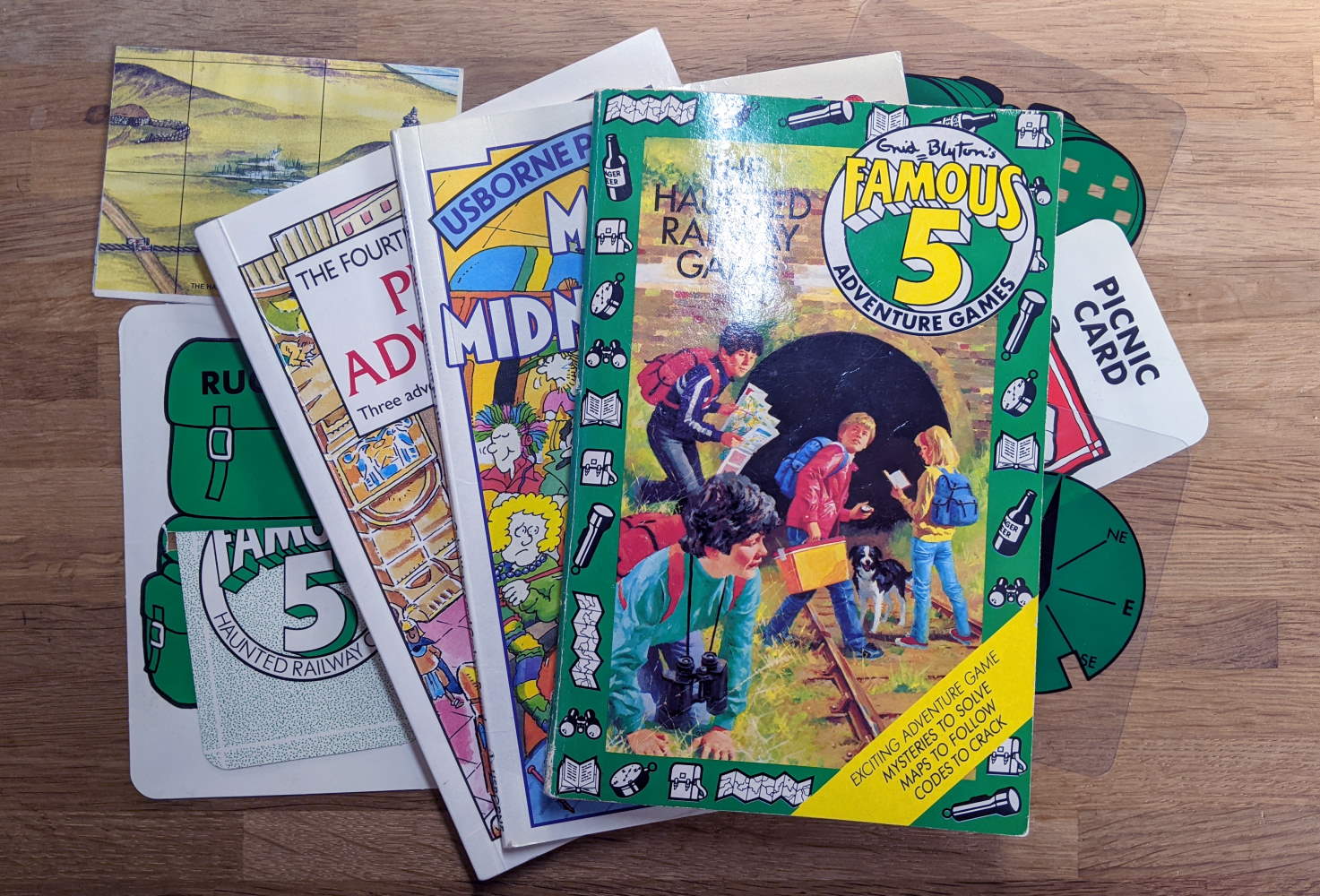
Combining the formats
One of the challenges in creating hybrid experiences is how to we switch between the physical book and online content. It’s the same challenges we see in other hybrid games: for example, in a city-wide game – how do we connect your location in the world with the digital clues / information? One solution is that we could have everything be entirely digital. The book could be completely online or app-based and then it’s almost seamless to have other digital content appear. Obviously, a physical book has many benefits (and drawbacks) over a digital version. Being tactical and being able to quickly flick pages and scan back and forth in a physical book is certainly attractive. A physical item can be gifted and passed on. A physical book can be used without any additional digital requirements (perhaps it’s needs online access for the full experience – but it can still be enjoyed without it).
The main reason for me is (as I have discussed in many blog posts on here) the number of ‘Points of Interaction’. If you want the game to be engaging for more players – then give them more ‘things’ to interact with simultaneously.
It’s not necessarily a 1 to 1 relationship, but if you want a 2 player experience – 2 ‘things’ is a good idea. Think of a multi-player boardgame and all the pieces that can be interacted with at the same time (some that are private to me). As a player I want to be able to handle things directly.
In the case of ARfA, the two things are book and a QR capable mobile phone. This allows the two players to handle a thing separately – or take it in turns. It allows us to combine information from the book with the phone (as you can see them both at the same time). The book could even be described as a collection of ‘things’ i.e. pages. It’s easy to refer back to earlier pages in the book to cross reference if we need to.
There’s still a decision about whether the digital component should be an App, a single responsive website or a collection of websites. Currently, we’re using mini-websites as this is the quickest way to get users involved. I’ve been favouring websites over apps where possible (as the app install process can be off putting to some). However, when it’s an experience that you’re dedicating a few hours to sometimes an app install is better in the long term and allows all the downloading of content to happen up front.
Is the Future AR?
While I’m sure in the long-term Augmented Reality will be a massive success, so far, most AR experiences for the public have been quite gimmicky. Honestly, I find it quite draining to view pop-up content animations through a mobile or tablet screen. That said there is absolutely a use-case of AR for this project and we hope to do some R&D in this area. Rather than scanning QR codes – pointing the phone / tablet at the page could result in more seamless transitions.
Again, this isn’t new technology but has never really caught on. I’m sure you’ve scanned AR posters or brochures that have some pop-up animated 3D content. I’m slightly less keen on 3D pop-ups – but I have used AR to bring wall portraits to life - a 2D video plays on top of the image so they begin talking to you.
AR has been used in children’s books, for example Little Hippo have an AR series of books called Hippo Magic. They have an accompanying app (Hippo Magic App) which looks to have been built for them by AR development house LiveAnimation – who seem to prefer Vulforia as their AR technology platform. Although frankly the image Little Hippo use to sell the concept is absolutely terrifying!
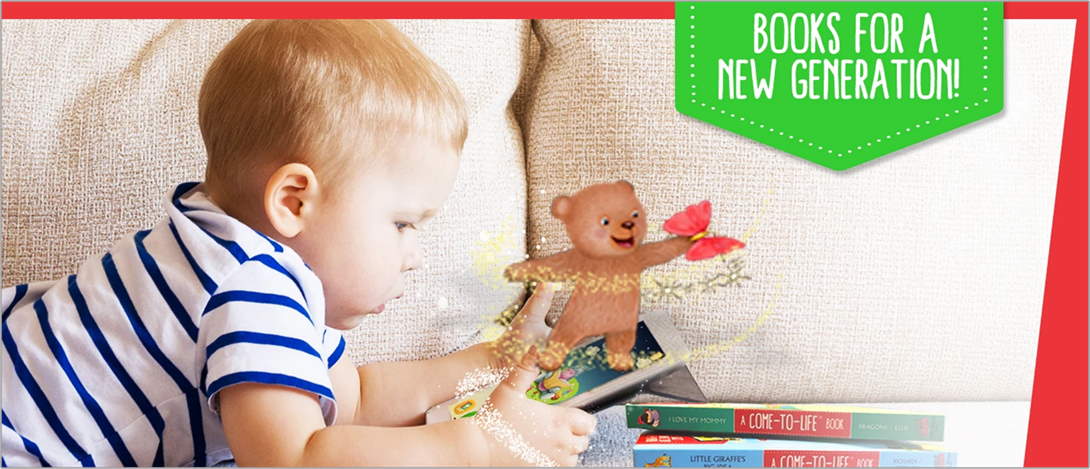
If we were to stick with mini-websites then we’d need to look at browser-based AR (Web-AR). This hasn’t been as popular so far but open source AR.js, MindAr, Pictarize and more commercial blippAR and Zappar are options.
Example Mini Game: Jigsaw
Let’s look at an example of one of the mini-websites. At this point in the story, Amala has ripped up her Haiku poem and run off. Nafeesa and Karim pull the pieces out of the fire pit and start to reassemble them. The player is tasked with helping Nafessa and Karim to assemble the poem and then try to interpret the meaning of it.
You can play the Jigsaw here (click the image or scan with a second device)
Technically this is built in pure javascript. The code and images are optimised so that it should run on the most basic of phones. In order to speed up development other more complex mini-games use other javascript libraries such as p5.js (Processing for the web).
Once the pieces are in approximately the correct positions – the game detects this and the pieces join together into a complete jigsaw. This makes it easier for the players to read Amala’s writing. They can use this to cross reference with some information in the book to try to figure out why Amala is sad.
It’s a good idea to use something like a jigsaw as a very early puzzle. It’s something that players are already familiar with and introduces them to the world and game style. Almost no explanation is needed and it will set the players up for more complex challenges as the book progresses.

Where Next?
At this stage we’re interested in getting feedback on the idea and prototype. And then we’re looking towards building the full version. Watch this space! Remember you can download the pdf of the prototype here and give us feedback here.
Special thanks to our amazing producer Tricia Coleman at The Other Ways Works, Fateha Begum who facilitated our school and community sessions and the children from Regents Park Community School in Birmingham.
